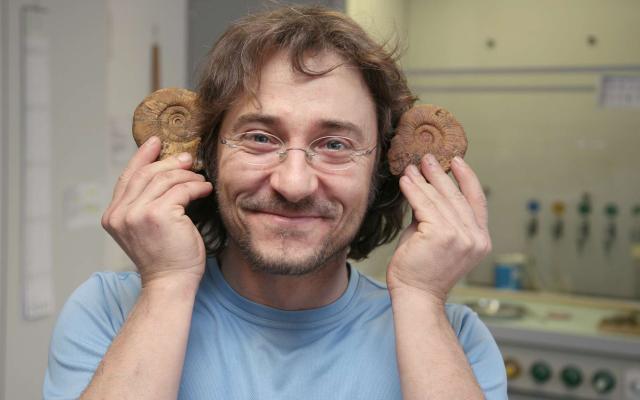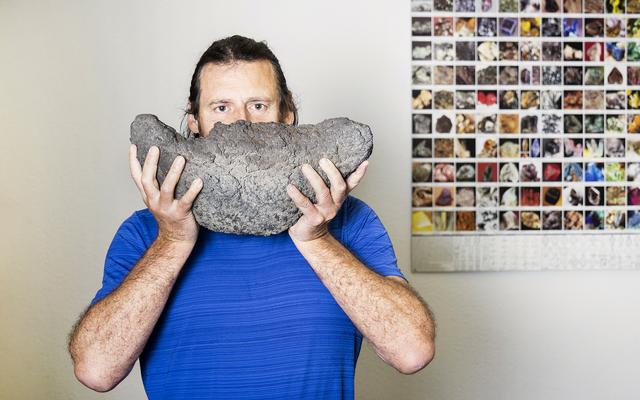The «Systematic Mineralogy» with minerals from all over the world is the largest mineral collection in our museum.
The main focus topically and at regional level is on minerals from alpinotype fissures from Switzerland. Among them, many of the great alpine discoveries of quartz crystals are documented (e.g. Vorderer Zinggenstock (1719), Tiefengletscher (1868), Gerstengletscher (1948), Rhonegletscher (1960), Gerstenegg (1974), Planggenstock (2005), but also smaller and rarer minerals in alpinotype fissures throughout Switzerland.
In addition to the „Systematic mineralogy”, there are various thematic and regional special collections: minerals from the Lengenbach quarry in the Binn valley; minerals from the Gotthard base tunnel; minerals with inclusions of biogenic structures.
The petrographic collections are mainly organized on a regional basis (Switzerland and abroad), but there are also some thematic collections available.
Historical collections of rocks from the 18th (Tscharner, Musterkollektion Funk) and 19th centuries (Bernhard Studer, Edmund von Fellenberg, Baltzer, Charpentier, Escher von der Linth and many more).
Other collections are for example: rocks of glaciological interest from the canton of Berne, reference collections from the construction of great alpine tunnels (tunnels of Simplon and Lötschberg, base tunnel of Lötschberg), rocks of the earth's mantle, impact rocks.
Research Associates/Ehrenamtliche Mitarbeitende
- Dr. Marco Buletti
-
Petrologie
Collection of ores from deposits in Switzerland and worldwide localities.
The meteorite collection worldwide contains about 250 different meteorites‘ names, amongst which the Swiss meteorites Rafrüti, Twannberg, Ulmiz and Utzenstorf.
The special collection «Oman meteorites» contains several thousand meteorite samples which have been collected within the frame of a research project in the sultanate of Oman since 2001.
The palaeontological collection is a dominantly regional collection focusing on invertebrate fossils (Precambrian to Pleistocene) with finds from the Molasse basin, the Jura mountains, the Alps and abroad. The emphasis of the paleaobotanic collection lies on the Carboniferous (Alps and abroad) and the Oligocene/Miocene (Molasse basins).
Fossil vertebrates mainly are from the Tertiary and the Jurassic (Molasse basin, Jura mountains, abroad).
About 4000 fossils figured in publications, among which 200 holotypes and over 300 paratypes, were deposited in the type collection from authors like Meisner (1820), Studer (1825), Ooster, W.A. & v. Fischer-Ooster, C. (1869, 1870-1871), Heer (1855) amongst others.
Nowadays, the main focus of the active research and collection lies on the Swiss Jura mountains (Lower to Late Jurassic). As a result of the donationof the collection of the Fondation paléontologique jurassienne (www.fpju.ch) to the museum, in 2017, the Jurassic collection has doubled in size and its value has increased even more.
Honorary associates
PD Dr. Jörn Geister (fossil and recent corals)
Dr. Christoph Gerber (fossil cartilaginous fishes)
Research Associates/Ehrenamtliche Mitarbeitende
- Dr. Christoph Gerber
-
Fossile Knorpelfische
- Georg Thormann
-
Molasse-Fossilien
It offers various sets for loan: suitcases with fossils, stones or minerals. Please contact the collection’s manager for information and loan requests.
Contacts Mineralogy, Petrography, Ores, Meteorites
Contacts Palaeontology


Earth sciences Curator palaeontology
Dr. Ursula Menkveld-Gfeller


Erdwissenschaften Wissenschaftlicher Mitarbeiter Paläontologie
Dr. Bernhard Hostettler


Erdwissenschaften Geowissenschaftlicher Präparator und Collection Manager



